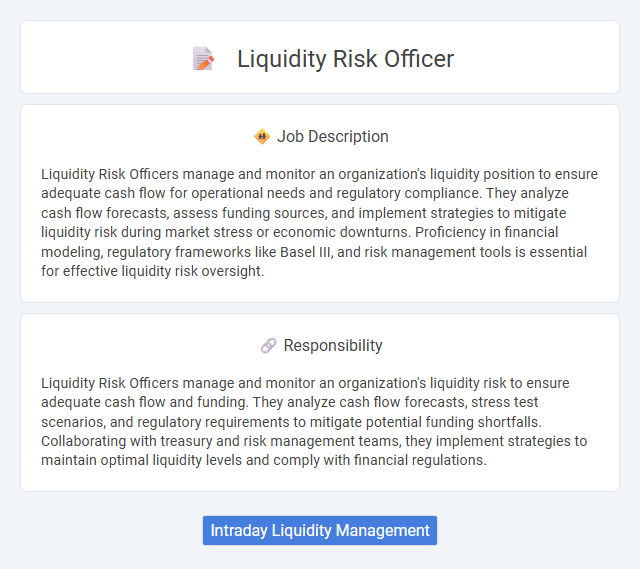
Liquidity Risk Officers manage and monitor an organization's liquidity position to ensure adequate cash flow for operational needs and regulatory compliance. They analyze cash flow forecasts, assess funding sources, and implement strategies to mitigate liquidity risk during market stress or economic downturns. Proficiency in financial modeling, regulatory frameworks like Basel III, and risk management tools is essential for effective liquidity risk oversight.
Individuals with strong analytical skills and a detail-oriented mindset are likely suitable for a Liquidity Risk Officer role due to its focus on assessing and managing financial risks. Those comfortable working under pressure and making data-driven decisions may find this position aligns well with their strengths. However, people who struggle with complex regulatory environments or have difficulty interpreting quantitative data might face challenges in this job.
Qualification
A Liquidity Risk Officer must possess a strong background in finance, risk management, or economics, typically holding a bachelor's degree in these fields, with many employers preferring candidates with advanced degrees such as an MBA or a master's in finance. Proficiency in quantitative analysis, stress testing, and regulatory frameworks like Basel III is essential for accurately assessing and managing liquidity risk. Experience with financial modeling software, excellent communication skills, and knowledge of market and credit risk further enhance an officer's ability to develop robust liquidity risk strategies and ensure regulatory compliance.
Responsibility
Liquidity Risk Officers manage and monitor an organization's liquidity risk to ensure adequate cash flow and funding. They analyze cash flow forecasts, stress test scenarios, and regulatory requirements to mitigate potential funding shortfalls. Collaborating with treasury and risk management teams, they implement strategies to maintain optimal liquidity levels and comply with financial regulations.
Benefit
A Liquidity Risk Officer is likely to benefit from a critical role in ensuring an organization's financial stability by monitoring and managing liquidity risks effectively. This position often offers opportunities for professional growth due to its importance in regulatory compliance and risk mitigation strategies. The role may also provide competitive compensation and exposure to high-level decision-making within financial institutions.
Challenge
Liquidity Risk Officers likely confront significant challenges in accurately predicting cash flow uncertainties and market fluctuations that could impact an institution's liquidity position. The role probably demands constant vigilance in stress testing and scenario analysis to preempt potential funding crises. Managing these dynamic risks requires both advanced analytical skills and proactive communication with stakeholders to mitigate financial instability.
Career Advancement
A Liquidity Risk Officer plays a critical role in managing and monitoring an organization's liquidity risk to ensure financial stability and regulatory compliance. Career advancement opportunities include progression to Senior Risk Manager, Chief Risk Officer, or roles in treasury management, leveraging expertise in risk assessment, liquidity forecasting, and regulatory frameworks. Mastery of financial modeling, stress testing, and regulatory knowledge enhances prospects for leadership positions in banking and financial institutions.
Key Terms
Intraday Liquidity Management
A Liquidity Risk Officer specializing in Intraday Liquidity Management monitors and controls the bank's cash flows to ensure availability of funds throughout the business day, minimizing the risk of payment failures. They analyze real-time liquidity positions, coordinate with treasury teams, and implement strategies to optimize cash usage while complying with regulatory requirements like Basel III standards. Proficient use of liquidity forecasting tools and internal risk metrics is essential to maintain operational resilience and meet intraday payment obligations.
 kuljobs.com
kuljobs.com